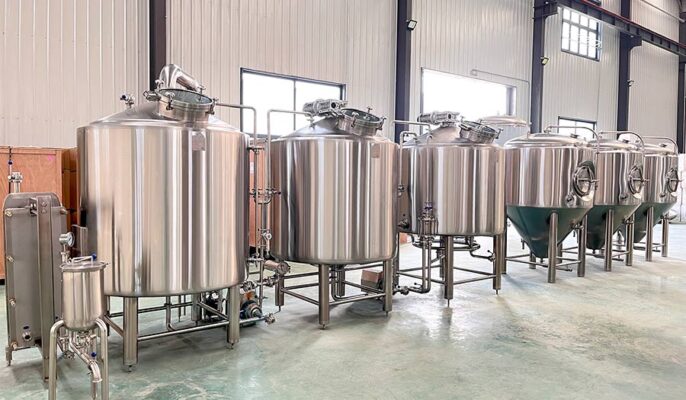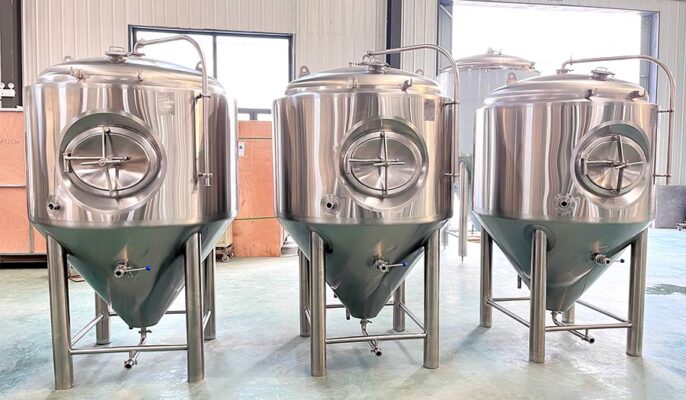With the rise of craft breweries and home brewing enthusiasts, there is an increasing demand for high-quality beer brewing equipment. The equipment used in beer brewing may vary depending on the size and complexity of the operation. If you are considering investing in the same , you must first understand the basic items and equipment required to brew enough quantities of beer for your purpose.
What is beer brewing equipment?
The brewery is where the brewing process begins, and beer brewing equipment refers to the machinery and tools used in the beer brewing process. It includes various ingredients that play a key role in the brewing process, from mashing and boiling to fermentation and packaging. Each piece of equipment helps create the unique flavor, aroma, and character of the final brew.
It usually consists of three main containers: a mash barrel, a lauter barrel, and a kettle. The mash tun is where the malted grains are mixed with hot water, promoting the enzymatic breakdown of starch into fermentable sugars. The resulting liquid, called wort , is then separated from the solid grain material in the lauter barrel. The wort is then transferred to a kettle and boiled to add hops and develop their flavors.
What parts does a brewery brewing equipment consist of?
- Brew Kettle: A brew kettle is a large vessel used to boil wort, a key step in the brewing process where hops are added to give the beer its bitter taste and aroma. These kettles are usually made of stainless steel or copper and come in various sizes to suit different batches.
- Fermenter: The fermenter is where the fermentation magic happens. Yeast converts sugar into alcohol and carbon dioxide, and the fermenter provides a controlled environment for this process. These tanks are crucial in determining the flavor profile and alcohol content of the beer.
- Mashing barrel: The mash barrel is a container used for mash. During the mash process, sprouted grains are mixed with hot water to convert starch into fermentable sugars. Proper mashing is critical to extracting the desired flavor and color from the grains.
- Wort cooler: After boiling, the hot wort needs to be cooled before yeast can be added for fermentation. Wort coolers reduce the temperature of your wort, preventing contamination and unwanted odors.
- Pumps: Pumps are used to transfer liquids between different vessels during the brewing process, such as wort and beer. They help maintain a steady flow and reduce the risk of oxidation.
- Cleaning system: A reliable cleaning system is crucial to maintain the hygiene of your brewing equipment. Proper cleaning and sanitation prevent contamination and ensure the consistency of the final product.
- Control Panel: Modern breweries often use control panels to automate and check the brewing process. These panels allow brewers to manage temperature, time, and other variables.

Beer brewing process
Beer is more than water, hops, malt, and yeast. During the beer brewing process, various ingredients are mixed, and processed, and sometimes the structure of the raw materials is also changed.
- Malt making
- Milling
- Mash
- Filtering
- Wort boiling
- Wort clarification
- Fermentation
- Storage
- Filling
How to choose beer brewing equipment?
Basics start
For beginners, it is wise to start with the basics. A basic home brewing kit usually includes the essentials such as a fermentation vessel, airlock, hydrometer, thermometer, and siphon. These items are the basis for brewing your first batch of beer and are relatively affordable.
Consider batch size
The size of the batch will determine the size of the device. Small batches are ideal for beginners because they are easier to manage and need less space. But, if you plan to brew a lot of beer, you will need a larger fermenter, kettle , and storage container. Assess your brewery’s expected production capacity. Consider factors such as batch size, brewing frequency, and projected growth. Choosing equipment with the appropriate capacity ensures you can meet your needs while maintaining consistent quality.
Quality selection
Invest in quality equipment that will stand the test of time. Stainless steel is the material of choice for many brewing vessels due to its durability, ease of cleaning, and resistance to rust and corrosion. High-quality equipment may be expensive upfront, but it pays off in the long run by reducing the risk of contamination and the need for frequent replacement.

Budget considerations
Craft beer equipment ranges from budget to high-end. Determine your budget ahead of time and focus on important projects. As you gain experience and confidence in your brewing skills, you can always upgrade and expand your equipment collection.
Calculate variable costs
Raw materials, water, electricity, personnel, and other administrative costs will take a toll if not planned. It is best to conduct a cost-benefit analysis with the equipment manufacturer in advance based on local consumption levels and equipment location. You can even provide us with your business plan or investment plan and we can help you using our extensive industry experience.
Choose the right supplier
There are many suppliers of brewing vessels, especially given the boom in new breweries over the past decade. But most suppliers don’t build their boats. Instead, they are usually imported from manufacturers in China or other countries. While this can reduce costs for customers, the quality of design, materials, and build varies.
Investing in quality commercial brewing equipment is a fundamental step in achieving your brewery goals. By evaluating production capabilities, prioritizing durability, considering customization options, and focusing on energy efficiency, ease of use, and long-term support, you can make informed decisions that put your brewery on the path to success.




